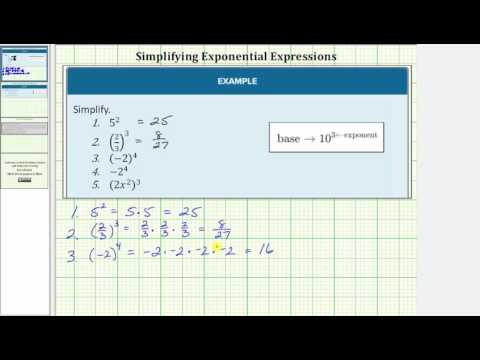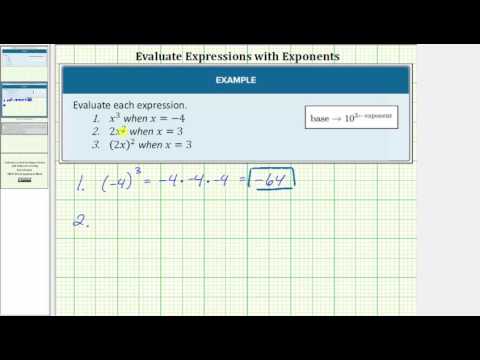4.2: Terms and Expressions With Exponents
- Page ID
- 51459
\( \newcommand{\vecs}[1]{\overset { \scriptstyle \rightharpoonup} {\mathbf{#1}} } \)
\( \newcommand{\vecd}[1]{\overset{-\!-\!\rightharpoonup}{\vphantom{a}\smash {#1}}} \)
\( \newcommand{\dsum}{\displaystyle\sum\limits} \)
\( \newcommand{\dint}{\displaystyle\int\limits} \)
\( \newcommand{\dlim}{\displaystyle\lim\limits} \)
\( \newcommand{\id}{\mathrm{id}}\) \( \newcommand{\Span}{\mathrm{span}}\)
( \newcommand{\kernel}{\mathrm{null}\,}\) \( \newcommand{\range}{\mathrm{range}\,}\)
\( \newcommand{\RealPart}{\mathrm{Re}}\) \( \newcommand{\ImaginaryPart}{\mathrm{Im}}\)
\( \newcommand{\Argument}{\mathrm{Arg}}\) \( \newcommand{\norm}[1]{\| #1 \|}\)
\( \newcommand{\inner}[2]{\langle #1, #2 \rangle}\)
\( \newcommand{\Span}{\mathrm{span}}\)
\( \newcommand{\id}{\mathrm{id}}\)
\( \newcommand{\Span}{\mathrm{span}}\)
\( \newcommand{\kernel}{\mathrm{null}\,}\)
\( \newcommand{\range}{\mathrm{range}\,}\)
\( \newcommand{\RealPart}{\mathrm{Re}}\)
\( \newcommand{\ImaginaryPart}{\mathrm{Im}}\)
\( \newcommand{\Argument}{\mathrm{Arg}}\)
\( \newcommand{\norm}[1]{\| #1 \|}\)
\( \newcommand{\inner}[2]{\langle #1, #2 \rangle}\)
\( \newcommand{\Span}{\mathrm{span}}\) \( \newcommand{\AA}{\unicode[.8,0]{x212B}}\)
\( \newcommand{\vectorA}[1]{\vec{#1}} % arrow\)
\( \newcommand{\vectorAt}[1]{\vec{\text{#1}}} % arrow\)
\( \newcommand{\vectorB}[1]{\overset { \scriptstyle \rightharpoonup} {\mathbf{#1}} } \)
\( \newcommand{\vectorC}[1]{\textbf{#1}} \)
\( \newcommand{\vectorD}[1]{\overrightarrow{#1}} \)
\( \newcommand{\vectorDt}[1]{\overrightarrow{\text{#1}}} \)
\( \newcommand{\vectE}[1]{\overset{-\!-\!\rightharpoonup}{\vphantom{a}\smash{\mathbf {#1}}}} \)
\( \newcommand{\vecs}[1]{\overset { \scriptstyle \rightharpoonup} {\mathbf{#1}} } \)
\( \newcommand{\vecd}[1]{\overset{-\!-\!\rightharpoonup}{\vphantom{a}\smash {#1}}} \)
\(\newcommand{\avec}{\mathbf a}\) \(\newcommand{\bvec}{\mathbf b}\) \(\newcommand{\cvec}{\mathbf c}\) \(\newcommand{\dvec}{\mathbf d}\) \(\newcommand{\dtil}{\widetilde{\mathbf d}}\) \(\newcommand{\evec}{\mathbf e}\) \(\newcommand{\fvec}{\mathbf f}\) \(\newcommand{\nvec}{\mathbf n}\) \(\newcommand{\pvec}{\mathbf p}\) \(\newcommand{\qvec}{\mathbf q}\) \(\newcommand{\svec}{\mathbf s}\) \(\newcommand{\tvec}{\mathbf t}\) \(\newcommand{\uvec}{\mathbf u}\) \(\newcommand{\vvec}{\mathbf v}\) \(\newcommand{\wvec}{\mathbf w}\) \(\newcommand{\xvec}{\mathbf x}\) \(\newcommand{\yvec}{\mathbf y}\) \(\newcommand{\zvec}{\mathbf z}\) \(\newcommand{\rvec}{\mathbf r}\) \(\newcommand{\mvec}{\mathbf m}\) \(\newcommand{\zerovec}{\mathbf 0}\) \(\newcommand{\onevec}{\mathbf 1}\) \(\newcommand{\real}{\mathbb R}\) \(\newcommand{\twovec}[2]{\left[\begin{array}{r}#1 \\ #2 \end{array}\right]}\) \(\newcommand{\ctwovec}[2]{\left[\begin{array}{c}#1 \\ #2 \end{array}\right]}\) \(\newcommand{\threevec}[3]{\left[\begin{array}{r}#1 \\ #2 \\ #3 \end{array}\right]}\) \(\newcommand{\cthreevec}[3]{\left[\begin{array}{c}#1 \\ #2 \\ #3 \end{array}\right]}\) \(\newcommand{\fourvec}[4]{\left[\begin{array}{r}#1 \\ #2 \\ #3 \\ #4 \end{array}\right]}\) \(\newcommand{\cfourvec}[4]{\left[\begin{array}{c}#1 \\ #2 \\ #3 \\ #4 \end{array}\right]}\) \(\newcommand{\fivevec}[5]{\left[\begin{array}{r}#1 \\ #2 \\ #3 \\ #4 \\ #5 \\ \end{array}\right]}\) \(\newcommand{\cfivevec}[5]{\left[\begin{array}{c}#1 \\ #2 \\ #3 \\ #4 \\ #5 \\ \end{array}\right]}\) \(\newcommand{\mattwo}[4]{\left[\begin{array}{rr}#1 \amp #2 \\ #3 \amp #4 \\ \end{array}\right]}\) \(\newcommand{\laspan}[1]{\text{Span}\{#1\}}\) \(\newcommand{\bcal}{\cal B}\) \(\newcommand{\ccal}{\cal C}\) \(\newcommand{\scal}{\cal S}\) \(\newcommand{\wcal}{\cal W}\) \(\newcommand{\ecal}{\cal E}\) \(\newcommand{\coords}[2]{\left\{#1\right\}_{#2}}\) \(\newcommand{\gray}[1]{\color{gray}{#1}}\) \(\newcommand{\lgray}[1]{\color{lightgray}{#1}}\) \(\newcommand{\rank}{\operatorname{rank}}\) \(\newcommand{\row}{\text{Row}}\) \(\newcommand{\col}{\text{Col}}\) \(\renewcommand{\row}{\text{Row}}\) \(\newcommand{\nul}{\text{Nul}}\) \(\newcommand{\var}{\text{Var}}\) \(\newcommand{\corr}{\text{corr}}\) \(\newcommand{\len}[1]{\left|#1\right|}\) \(\newcommand{\bbar}{\overline{\bvec}}\) \(\newcommand{\bhat}{\widehat{\bvec}}\) \(\newcommand{\bperp}{\bvec^\perp}\) \(\newcommand{\xhat}{\widehat{\xvec}}\) \(\newcommand{\vhat}{\widehat{\vvec}}\) \(\newcommand{\uhat}{\widehat{\uvec}}\) \(\newcommand{\what}{\widehat{\wvec}}\) \(\newcommand{\Sighat}{\widehat{\Sigma}}\) \(\newcommand{\lt}{<}\) \(\newcommand{\gt}{>}\) \(\newcommand{\amp}{&}\) \(\definecolor{fillinmathshade}{gray}{0.9}\)Learning Objectives
- Identify the components of a term containing integer exponents
- Evaluate expressions containing integer exponents
A lingua franca is a common language used to make communication possible between people who speak different languages. Math, as a general idea, is sometimes thought of as an example of a common language because formulas and equations don’t rely on fluency in a specific language.
But even within mathematics a common language is needed in order to communicate mathematical ideas clearly and efficiently. Exponential notation (remember this can also called scientific notation) was developed to write repeated multiplication more efficiently. For example, growth occurs in living organisms by the division of cells. One type of cell divides 2 times in an hour. So in 12 hours, the cell will divide \(2^{12}\). Expressing it this way is a much more efficient and clear way to express the ways cells divide.
In this section we will learn how to simplify and perform mathematical operations such as multiplication and division on terms that have exponents. We will also learn how to use scientific notation to represent very large or very small numbers, and perform mathematical operations on them.
Anatomy of exponential terms
We use exponential notation to write repeated multiplication. For example \(10^{3}\). The 10 in \(10^{3}\) is called the exponent. The expression \(10^{3}\) is called the exponential expression. Knowing the names for the parts of an exponential expression or term will help you learn how to perform mathematical operations on them.
\(\text{base}\rightarrow10^{3\leftarrow\text{exponent}}\)
\(10\cdot10\cdot10\), or 1,000.
\(8\cdot8\), or 64.
\(5\cdot5\cdot5\cdot5\), or 625.
\({b}\cdot{b}\cdot{b}\cdot{b}\cdot{b}\). Its value will depend on the value of b.
The exponent applies only to the number that it is next to. Therefore, in the expression \(xy^{4}\) means \({x}\cdot{y}\cdot{y}\cdot{y}\cdot{y}\). The x in this term is a coefficient of y.
If the exponential expression is negative, such as \(–\left(3\cdot3\cdot3\cdot3\right)\) or \(−81\).
If \(\left(−3\right)^{4}\), which means \(−3\cdot−3\cdot−3\cdot−3\), or 81.
Likewise, \(−x^{4}=–\left(x\cdot x\cdot x\cdot x\right)\).
You can see that there is quite a difference, so you have to be very careful! The following examples show how to identify the base and the exponent, as well as how to identify the expanded and exponential format of writing repeated multiplication.
Example
Identify the exponent and the base in the following terms, then simplify:
- \(7^{2}\)
- \({\left(\frac{1}{2}\right)}^{3}\)
- \(2x^{3}\)
- \(\left(-5\right)^{2}\)
[reveal-answer q=”211363″]Show Solution[/reveal-answer]
[hidden-answer a=”211363″]
1) \(7^{2}\)
The exponent in this term is 2 and the base is 7. To simplify, expand the term: \(7^{2}=7\cdot{7}=49\)
2) \({\left(\frac{1}{2}\right)}^{3}\)
The exponent on this term is 3, and the base is \({\left(\frac{1}{2}\right)}^{3}=\frac{1}{2}\cdot{\frac{1}{2}}\cdot{\frac{1}{2}}=\frac{1}{16}\)
3) \(2x^{3}\)
The exponent on this term is 3, and the base is x, the 2 is not getting the exponent because there are no parentheses that tell us it is. This term is in its most simplified form.
4) \(\left(-5\right)^{2}\)
The exponent on this terms is 2 and the base is \(\left(-5\right)^{2}=-5\cdot{-5}=25\)
[/hidden-answer]
In the following video you are provided more examples of applying exponents to various bases.
Evaluate expressions
Evaluating expressions containing exponents is the same as evaluating the linear expressions from earlier in the course. You substitute the value of the variable into the expression and simplify.
You can use the order of operations to evaluate the expressions containing exponents. First, evaluate anything in Parentheses or grouping symbols. Next, look for Exponents, followed by Multiplication and Division (reading from left to right), and lastly, Addition and Subtraction (again, reading from left to right).
So, when you evaluate the expression \(x=4\), first substitute the value 4 for the variable x. Then evaluate, using order of operations.
Example
Evaluate \(x=4\).
[reveal-answer q=”411363″]Show Solution[/reveal-answer]
[hidden-answer a=”411363″]
Substitute 4 for the variable x.
\(5\cdot4^{3}\)
Evaluate \(4^{3}\). Multiply.
\(5\left(4\cdot4\cdot4\right)=5\cdot64=320\)
Answer
\(x=4\)
[/hidden-answer]
In the example below, notice the how adding parentheses can change the outcome when you are simplifying terms with exponents.
Example
Evaluate \(x=4\).
[reveal-answer q=”362021″]Show Solution[/reveal-answer]
[hidden-answer a=”362021″]Substitute 4 for the variable x.
\(\left(5\cdot4\right)3\)
Multiply inside the parentheses, then apply the exponent—following the rules of PEMDAS.
\(20^{3}\)
Evaluate \(20^{3}\).
\(20\cdot20\cdot20=8,000\)
Answer
\(x=4\)
[/hidden-answer]
The addition of parentheses made quite a difference! Parentheses allow you to apply an exponent to variables or numbers that are multiplied, divided, added, or subtracted to each other.
Example
Evaluate \(x=−4\).
[reveal-answer q=”86290″]Show Solution[/reveal-answer]
[hidden-answer a=”86290″]Substitute \(−4\) for the variable x.
\(\left(−4\right)^{3}\)
Evaluate. Note how placing parentheses around the \(−4\) means the negative sign also gets multiplied.
\(−4\cdot−4\cdot−4\)
Multiply.
\(−4\cdot−4\cdot−4=−64\)
Answer
\(x=−4\)
[/hidden-answer]

Caution! Whether to include a negative sign as part of a base or not often leads to confusion. To clarify whether a negative sign is applied before or after the exponent, here is an example.
What is the difference in the way you would evaluate these two terms?
- \(-{3}^{2}\)
- \({\left(-3\right)}^{2}\)
To evaluate 1), you would apply the exponent to the three first, then apply the negative sign last, like this:
\(\begin{array}{c}-\left({3}^{2}\right)\\=-\left(9\right) = -9\end{array}\)
To evaluate 2), you would apply the exponent to the 3 and the negative sign:
\(\begin{array}{c}{\left(-3\right)}^{2}\\=\left(-3\right)\cdot\left(-3\right)\\={ 9}\end{array}\)
The key to remembering this is to follow the order of operations. The first expression does not include parentheses so you would apply the exponent to the integer 3 first, then apply the negative sign. The second expression includes parentheses, so hopefully you will remember that the negative sign also gets squared.
In the next sections, you will learn how to simplify expressions that contain exponents. Come back to this page if you forget how to apply the order of operations to a term with exponents, or forget which is the base and which is the exponent!
In the following video you are provided with examples of evaluating exponential expressions for a given number.
- Simplify Basic Exponential Expressions. Authored by: James Sousa (Mathispower4u.com) for Lumen Learning. Located at: https://youtu.be/ocedY91LHKU. License: CC BY: Attribution
- Revision and Adaptation. Provided by: Lumen Learning. License: CC BY: Attribution
- Screenshot: Repeated Image. Provided by: Lumen Learning. License: CC BY: Attribution
- Evaluate Basic Exponential Expressions. Authored by: James Sousa (Mathispower4u.com) for Lumen Learning. Located at: https://youtu.be/pQNz8IpVVg0. License: CC BY: Attribution
- Unit 11: Exponents and Polynomials, from Developmental Math: An Open Program. Provided by: Monterey Institute of Technology and Education. Located at: nrocnetwork.org/resources/downloads/nroc-math-open-textbook-units-1-12-pdf-and-word-formats/. License: CC BY: Attribution



